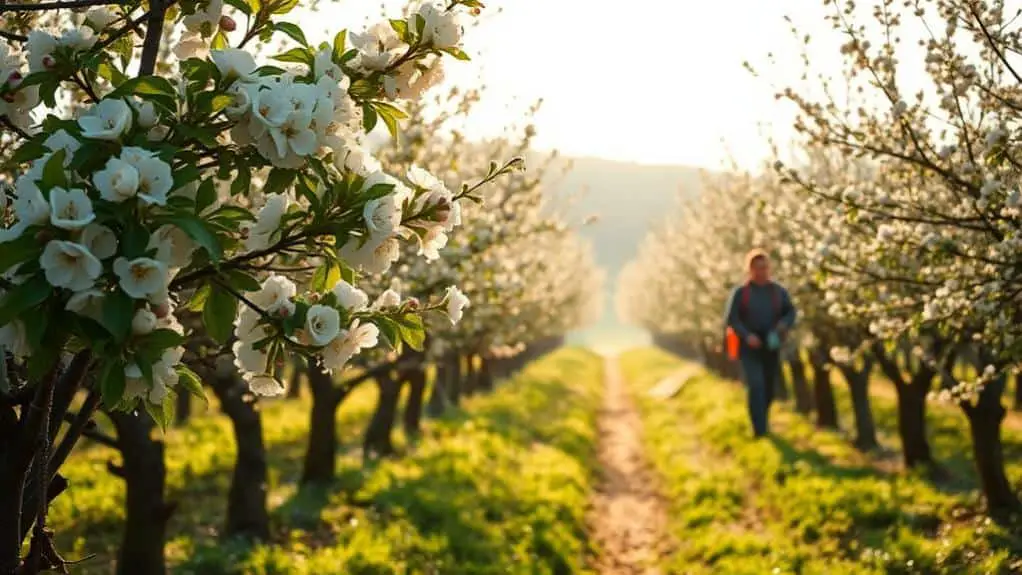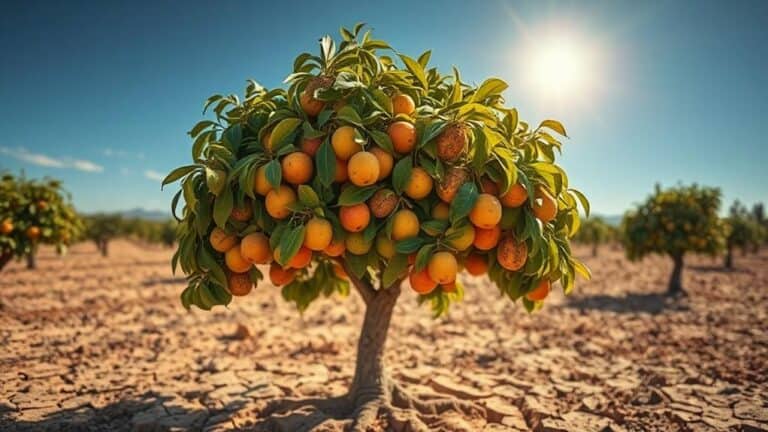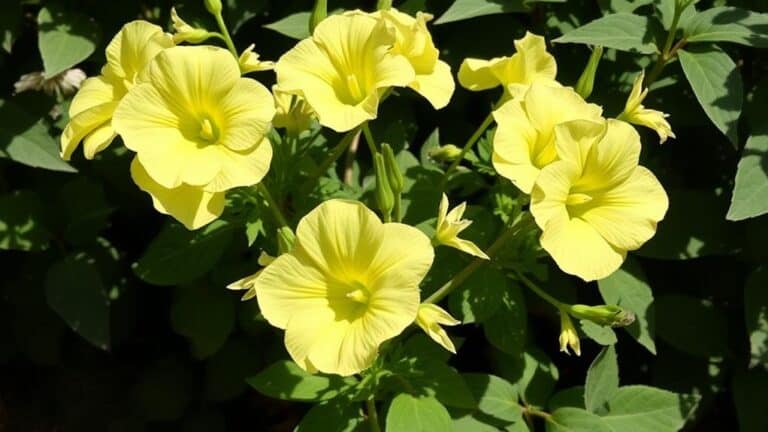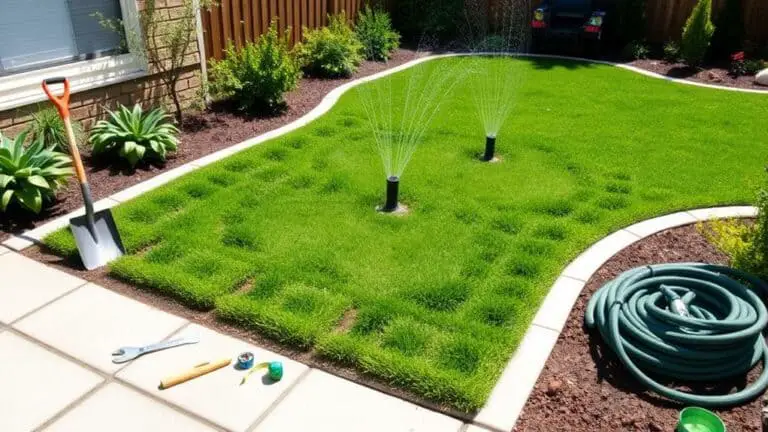Best Time Of Year To Spray Fruit Trees
When it comes to spraying fruit trees, timing is everything. I've found that understanding the seasonal windows can make all the difference in promoting tree health and maximizing fruit yield. Dormant sprays, for instance, are best applied in late winter to early spring before leaf buds open. But did you know that fungicide sprays are most effective just before bud break? And that's only the beginning; there's more to take into account as the season progresses, especially after petal fall. Curious about how to guarantee your fruit trees thrive throughout the growing season? Let's explore the specifics.
Dormant Sprays
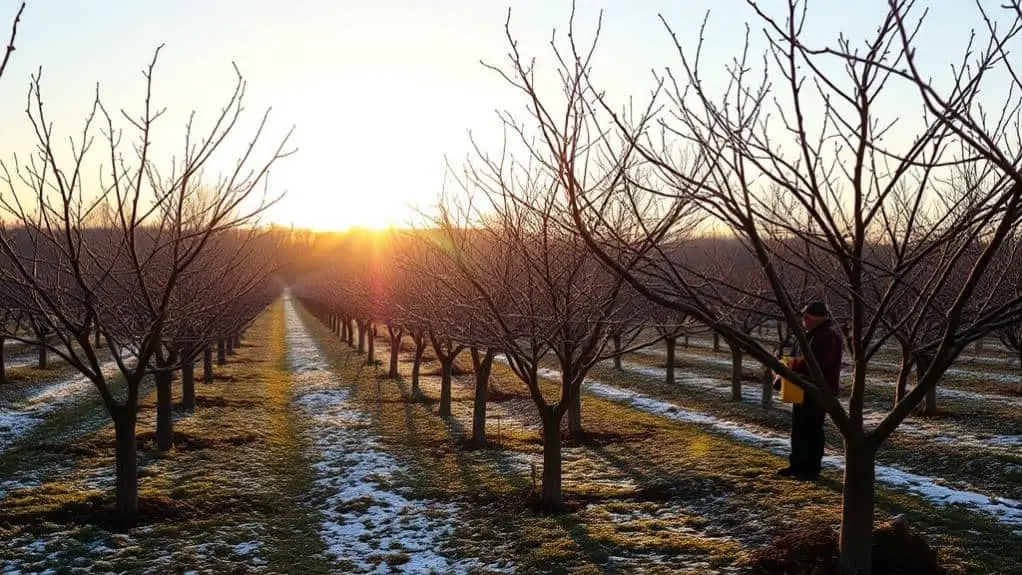
During late winter to early spring, it's crucial to apply dormant sprays to fruit trees before the leaf buds open. This timing targets overwintering pests and diseases effectively.
You'll want to use horticultural oil, like mineral or cottonseed oil, when temperatures are above 40°F (4°C). These oils help control pests such as mites, aphids, and scale, and can also combat diseases like powdery mildew.
I've found that most fruit trees need dormant oil applications every five years, but if there's a significant infestation, you might need to spray more frequently.
Be sure not to apply dormant sprays when it's too cold, as it could damage the tree and reduce the oil's effectiveness.
Fungicide Sprays Before Bud Break
Applying fungicide sprays before bud break is essential for maintaining the health of your fruit trees. In early spring, when flower buds begin to swell, it's the perfect time to apply a fungicide spray. This timing is vital because it helps prevent diseases like apple scab and powdery mildew.
To get the best results, spray when the temperature is around 60°F (15°C). I recommend using natural sulfur-based or chemical fungicidal sprays.
Apply the first spray as flower buds develop, then follow up with a second spray 10-14 days later. This proactive approach greatly reduces the risk of fungal infections, ensuring your trees stay healthy and produce beautiful, disease-free fruit throughout the season.
Spraying During Bloom Time
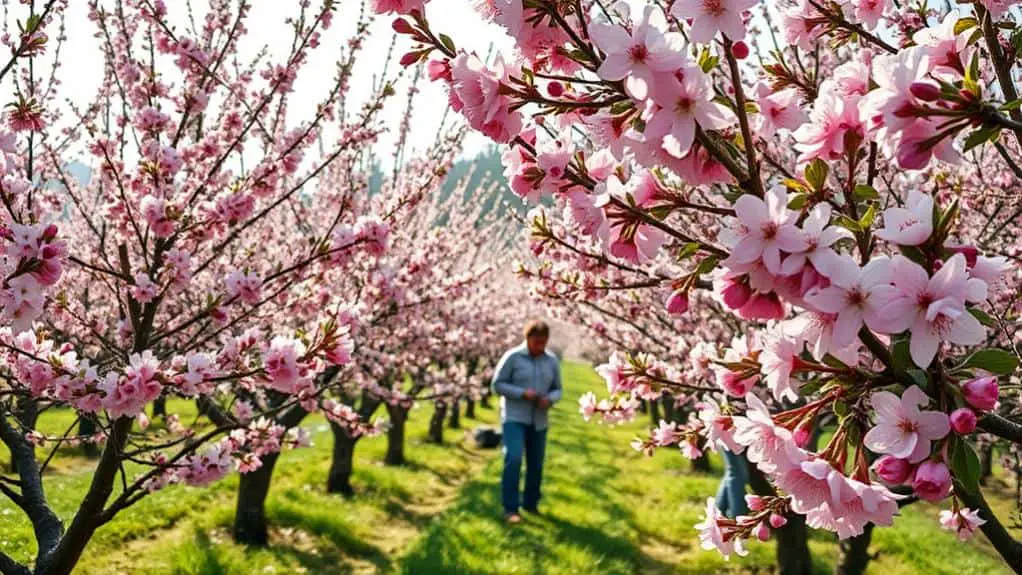
After successfully applying fungicide sprays before bud break, it's important to contemplate the timing and necessity of sprays during the bloom period. Spraying fruit trees during full bloom is generally discouraged because it can damage flowers and impact fruit development. However, certain pests and diseases like fireblight and the European Apple Sawfly may emerge during this time, requiring careful timing for treatments. To minimize harm to pollinators and blossoms, it's best to spray before full bloom or immediately after petals fall.
| Timing | Action | Purpose |
|---|---|---|
| Before Bloom | Apply recommended sprays | Prevent early pest/disease issues |
| Full Bloom | Avoid spraying | Protect flowers and pollinators |
| After Petal Fall | Apply targeted treatments | Manage pests like fireblight |
Using products like Copper Octanoate cautiously during bloom can help manage fireblight while protecting your trees.
Combination Sprays After Petal Fall
After petal fall, it's super important to time your combination sprays just right to keep those pesky insects and diseases at bay.
I usually aim for a second spray two weeks after petal fall, especially to manage codling moths, and then keep an eye on things through the summer.
This way, you can guarantee your fruit trees stay healthy and produce a great yield!
Timing for Effective Control
Once the petals have fallen, it's time to get back to spraying to keep those pesky insects and diseases at bay.
The best time to spray fruit trees for effective control is right after petal fall. This helps target pests and diseases just as they start to affect fruit development. For instance, spraying for codling moths two weeks post petal fall can prevent larvae from damaging your fruit.
Using combination sprays with both insecticides and fungicides saves time by tackling multiple threats at once.
Monitoring your trees regularly is vital; it allows you to adjust your spray schedule based on pest activity and weather conditions. This way, you can guarantee your fruit trees stay healthy and productive all season long.
Managing Summer Pests
As the petals fall and we've tackled the initial wave of pests, our focus shifts to managing summer pests efficiently. Fruit tree spraying after petal fall is vital. Combination sprays target both insects and diseases, which helps in maintaining tree health. You'll need to apply a second insecticidal spray two weeks after petal fall, especially for codling moth control. This timing is essential to stop larvae before they damage the fruit. Continuous spraying might be necessary during mid-summer to handle emerging threats.
Here's a helpful table:
| Timeframe | Action Required |
|---|---|
| After Petal Fall | Apply combination sprays |
| 2 Weeks Later | Second insecticidal spray for codling moth |
| Mid-Summer | Monitor and apply additional sprays |
| Ongoing | Regularly check tree health and pest activity |
Combination sprays save time, but always check product compatibility!
Timing for Dormant Oil Application
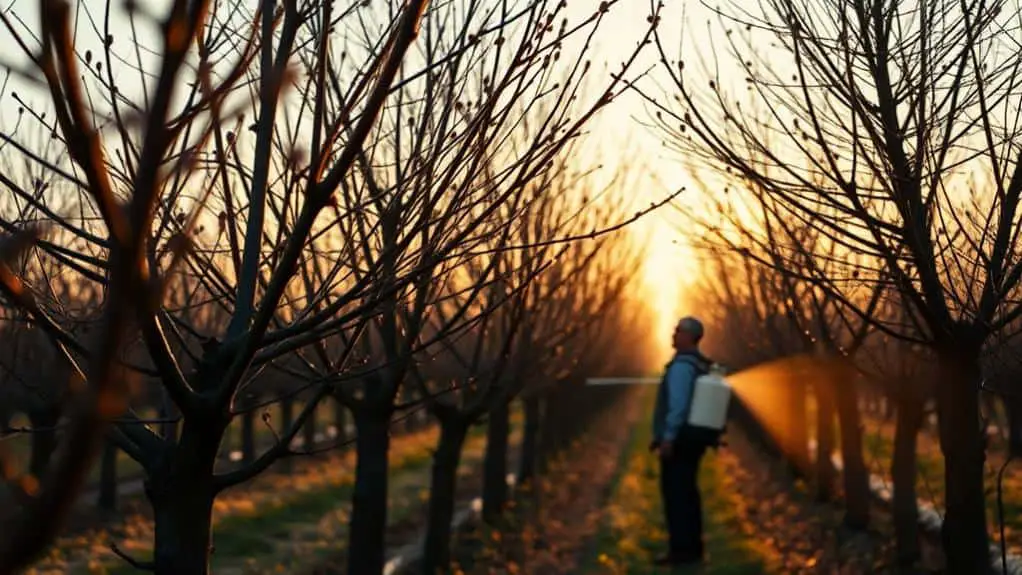
When it comes to spraying dormant oil on fruit trees, timing and temperature are key.
You'll want to aim for late winter to early spring, when temperatures are consistently above 40°F, so you can effectively target pests like mites and aphids.
Typically, giving your trees a good dormant oil treatment every five years works well, although if you're dealing with a big infestation, you might need to do it more often.
Ideal Temperature Range
Choosing the right time to spray dormant oil on your fruit trees is essential for effective pest control and tree health.
Ideally, you should apply dormant oil in late winter to early spring, before the leaf buds begin to swell. Make certain temperatures are consistently above 40°F (4°C) but not too high. Around 60°F (15°C) is perfect for certain fungicides, but dormant oil works best in cooler conditions.
Spraying too early, when temperatures might still drop, can lead to ineffective pest control and potential damage to your trees. Keep an eye on local weather forecasts and aim for a stable day in mid to late March for the best results.
This timing guarantees your trees stay healthy and pest-free.
Target Pests Effectively
Timing is everything when it comes to targeting pests effectively with dormant oil. You need to spray during late winter or early spring, specifically in mid to late March, when temperatures are above 40°F (4°C). This period is essential because overwintering pests like mites and scale are still inactive, making it easier to manage them. Fruit tree sprays during the dormant season help prevent pest and disease outbreaks before bud swelling begins. Keep an eye on weather forecasts to avoid spraying if temperatures will drop below 40°F within 24 hours.
Here's a quick guide:
| Time to Spray | Ideal Temperature | Target Pests |
|---|---|---|
| Late Winter | Above 40°F (4°C) | Mites, Scale |
| Early Spring | Above 40°F (4°C) | Wooly Apple Aphids |
| Mid to Late March | Above 40°F (4°C) | Overwintering Pests |
Application Frequency Guidelines
Applying dormant oil at the right frequency is essential for maintaining the health of your fruit trees. Typically, you should apply dormant oil once every five years, but if you have a large infestation of pests like overwintering scale, you might need to do it more often.
The best time to apply dormant oil is in late winter or early spring, ideally between mid to late March, when temperatures are above 40°F (4°C). This timing coincides with the end of the dormant season as buds start to swell.
Monitoring your trees for pest activity before applying the oil can help you decide if treatment is necessary, improving your overall pest management strategy and ensuring a healthy grow season.
Pest Management in Early Spring
Early spring is an essential window for managing pests on fruit trees, and getting the timing right can make all the difference.
During this time, applying dormant sprays is key to controlling overwintering tree pests like mites and scales. You'll want to use horticultural oils, such as mineral or cottonseed oil, especially when temperatures rise above 40°F. This helps in managing pests and diseases like powdery mildew.
For fungicidal spray, aim to apply just before bud break when it's around 60°F to combat issues like apple scab. Monitoring your trees for pest activity is important to determine when to spray.
Trust me, timely pest management in early spring sets your fruit trees up for a healthy growing season!
Importance of Seasonal Spraying
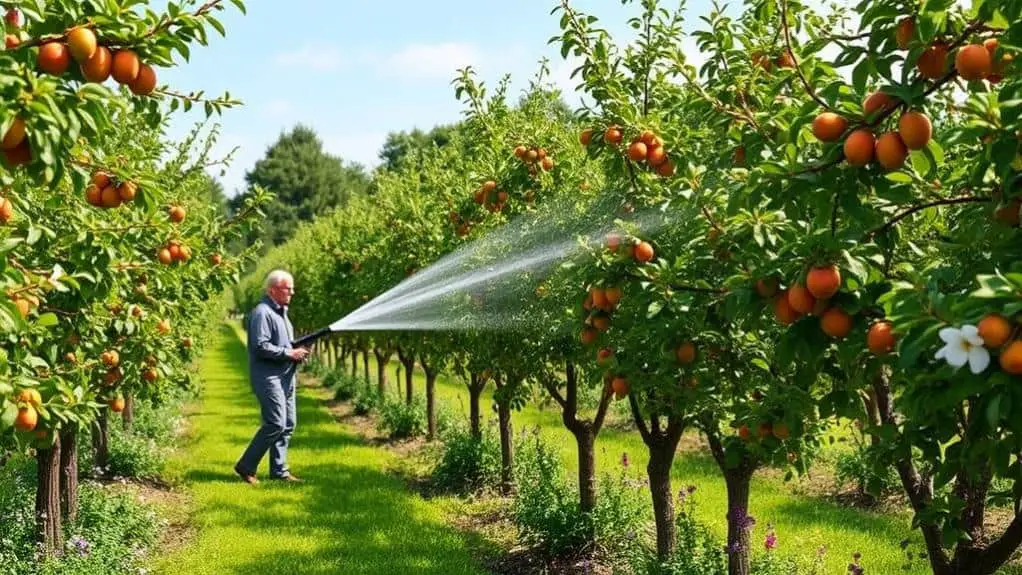
Each season brings its own set of challenges for fruit trees, making seasonal spraying a critical component of effective pest and disease management.
Seasonal spraying guarantees that we tackle different threats at the right times. For example, dormant sprays in late winter or early spring help target overwintering insect pests like mites and scales.
By applying fungicidal sprays just before bud break, we can prevent diseases and insects, such as apple scab.
After petal fall, combining insecticidal and fungicidal sprays helps manage ongoing pest pressures.
Understanding fruit tree spray schedules means knowing when to act during dormancy, bloom, and fruit formation.
This way, we maximize tree health and fruit yield while protecting beneficial insects.
Summer Spray Schedule
Let's get into the summer spray schedule!
After the petals fall and the fruit sets, it's essential to start applying insecticides every two weeks to keep pests like codling moths and apple maggot flies in check.
Using products like Surround, which contains kaolin clay, can create a protective barrier on the fruit, enhancing our pest control efforts and ensuring a healthy harvest.
Post-Petal Fall Treatments
The post-petal fall period is a significant moment in orchard care, as it marks the onset of fruit set and the need to tackle emerging pest threats.
After petal fall, applying insecticidal sprays is essential to manage pests like codling moths. Here's what you should do:
- Apply insecticidal sprays: Two weeks after petal fall, use sprays to control codling moth populations.
- Continue summer sprays: Maintain spray applications throughout the growing season until harvest to keep pests at bay.
- Use kaolin clay products: Products like Surround can enhance pest control without harming the trees.
- Monitor pest activity: Regular checks help adjust your spray schedule to guarantee healthy, productive fruit trees.
Insect Control Techniques
When exactly should you start your summer spray schedule to effectively control insects on your fruit trees? Well, it's vital to begin right after petal fall. This is when the fruit sets, and pests like codling moths can start causing trouble.
You'll want to spray the trees at two-week intervals throughout the summer to keep these pests in check. Two weeks after petal fall, another treatment is necessary to guarantee thorough insect control.
Organic insecticides and products like kaolin clay (Surround) work wonders by creating a barrier that deters pests.
Don't forget to monitor for specific pests, like apple maggot flies, using traps. This careful and regular attention helps protect your fruit and keep your trees healthy!
Effective Use of Combination Sprays
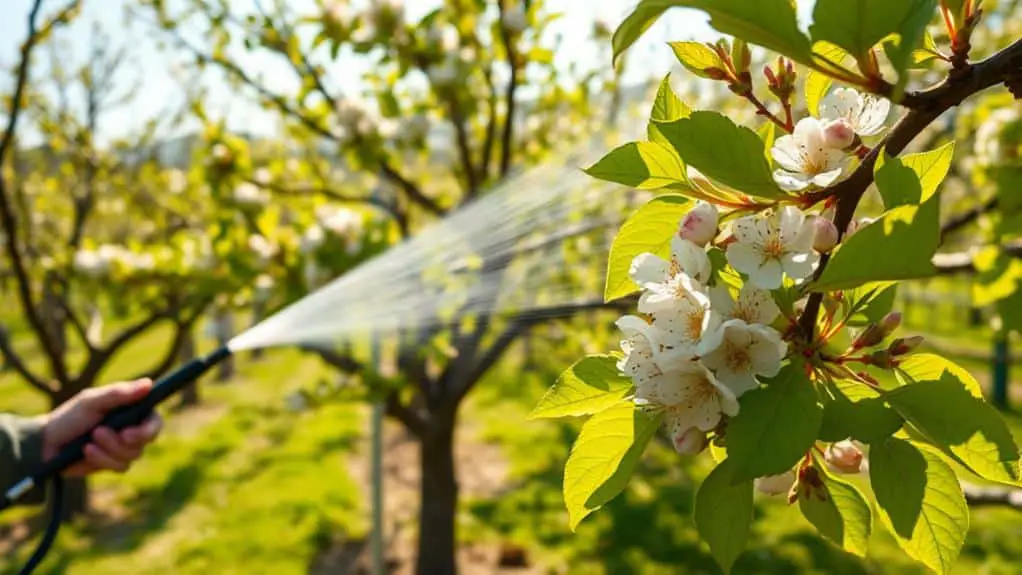
While caring for fruit trees, you might find that combination sprays offer a highly efficient solution.
These sprays mix insecticides and fungicides to tackle pests and diseases simultaneously, saving you time.
Here's how to use them effectively:
- Apply After Petal Fall: This is the perfect time to target insects like codling moths and fungal diseases during the growing season.
- Check Compatibility: Always confirm the products you mix are safe and effective together to avoid any issues.
- Adhere to Application Rates: Follow the label instructions for timing and amounts to keep your fruit trees healthy.
- Regular Applications: Especially in mid-summer, consistent use of combination sprays can maintain tree health and reduce pest and disease pressures.
Using these tips, your fruit trees should flourish!
Understanding Local Weather Patterns
Understanding local weather patterns is essential for effective fruit tree care.
I've learned that temperature, humidity, and frost dates greatly influence the timing of spray applications. For example, dormant oils work best around 40°F (4°C). Fungicides need around 60°F (15°C). Humidity levels also matter since high humidity can increase pest activity.
Rainfall patterns are important too—spraying just before rain can wash away treatments, so reapplication might be needed.
Monitoring local frost dates is crucial; a late frost can damage your trees and treatments. Knowing when bud break and bloom times occur helps in scheduling sprays to protect at key growth stages.
Frequently Asked Questions
When Should I Spray Fruit Trees?
I spray my fruit trees considering ideal temperatures and pest prevention. For tree health, I use timing techniques based on seasonal considerations. Dormant sprays go on in late winter, avoiding bloom time, and monitor regularly for best results.
What Is the Best Spray to Use on Fruit Trees?
When you ask about the best spray, I'd recommend using organic pesticides for pest control and sulfur-based sprays for fungal diseases. Regular seasonal maintenance with these can greatly improve tree health and guarantee your fruit trees thrive.
Can You Spray Fruit Trees so They Don't Produce Fruit?
Yes, you can spray fruit trees to prevent fruit production. Alongside fruit tree pruning and blossom thinning, using organic methods for pest prevention and considering seasonal timing guarantees effective control. Always follow guidelines for best results.
How Often Should I Spray Neem Oil on Fruit Trees?
I spray neem oil on my fruit trees every 7-14 days for pest control during infestations. For preventive benefits in organic gardening, I apply it once a month during the growing season, using proper application techniques and seasonal timing.
Conclusion
So, there you have it! Spraying your fruit trees at the right times throughout the year is key to keeping them healthy and productive. From dormant sprays in late winter to combination sprays after petal fall, each step is essential. Keep an eye on local weather and pest activity to make timely adjustments. By following this schedule, you'll help your fruit trees thrive, bringing you delicious fruit and a sense of accomplishment. Happy spraying!

